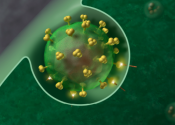Study reveals how HIV enters cell nucleus
Loyola University Chicago scientists have solved a mystery that has long baffled HIV researchers: How does HIV manage to enter the nucleus of immune system cells?
Jun 21, 2016
1
85
Loyola University Chicago scientists have solved a mystery that has long baffled HIV researchers: How does HIV manage to enter the nucleus of immune system cells?
Jun 21, 2016
1
85

Using gene editing technology, researchers at the Lewis Katz School of Medicine at Temple University have, for the first time, successfully excised a segment of HIV-1 DNA - the virus responsible for AIDS - from the genomes ...
May 19, 2016
0
79

HIV mutates rapidly and forms countless virus variants in the patient. A collaboration of scientists from the group of Richard Neher, Max Planck Institute for Developmental Biology in Tübingen, Germany, and scientists from ...
Dec 17, 2015
0
7

The virus that causes AIDS is an efficient and crafty retrovirus. Once HIV inserts its DNA into the genome of its host cells, it has a long incubation period, and can remain dormant and hidden for years. And while physicians ...
Apr 9, 2015
0
200

Imagine a suitcase on a bumpy ride. With enough jostling it opens, spilling clothes everywhere. Similarly awkward, the suitcase locks may jam and not open at the destination.
Dec 30, 2014
1
0

Genomic medicine is rapidly developing, bringing with its advances promises of individualized genetic information to tailor and optimize prevention and treatment interventions. Genetic tests are already guiding treatments ...
Sep 23, 2014
0
0
Fifteen years ago, MIT professor John Essigmann and colleagues from the University of Washington had a novel idea for an HIV drug. They thought if they could induce the virus to mutate uncontrollably, they could force it ...
Jul 28, 2014
1
0
The HIV-1 virus has proved to be tenacious, inserting its genome permanently into its victims' DNA, forcing patients to take a lifelong drug regimen to control the virus and prevent a fresh attack. Now, a team of Temple University ...
Jul 21, 2014
0
1

The key to future HIV treatment could be hidden right in our own genes. Everyone who becomes infected deploys defense strategies, and some even manage to hold the virus at bay without any therapy at all. This immune system ...
Oct 29, 2013
0
0
A team of scientists led by virologists Prof. Oliver T. Fackler and Prof. Oliver T. Keppler from Heidelberg University Hospital have decoded a mechanism used by the human immune system to protect itself from HIV viruses. ...
Oct 2, 2012
0
0